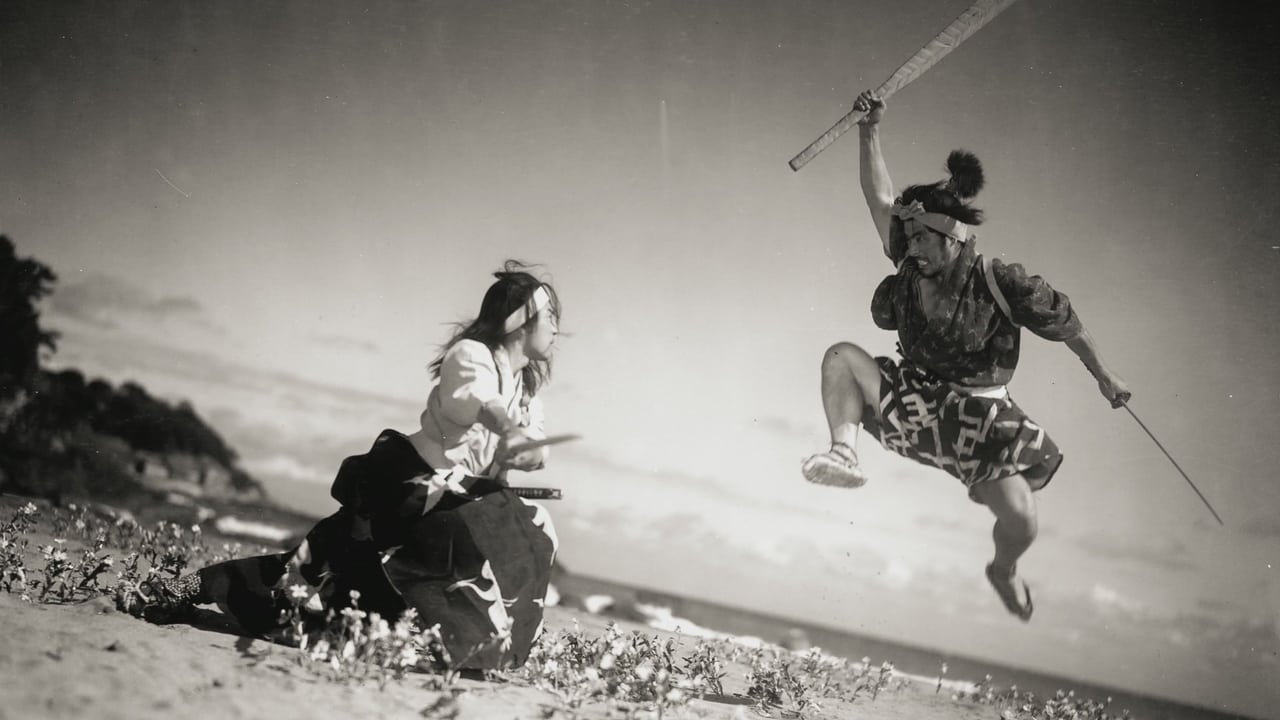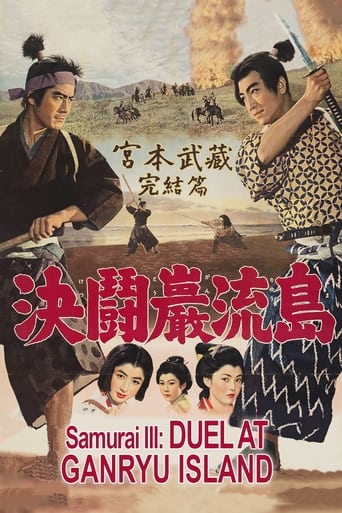



What a waste of my time!!!
Did you people see the same film I saw?
Absolutely the worst movie.
It's fun, it's light, [but] it has a hard time when its tries to get heavy.
View MoreHiroshi Inagaki's 1954-1956 three part color film, The Samurai Trilogy, is unlike many filmic trilogies for the very fact that it is, indeed, one exactly five hour long film, and not three separate linked films, for the first two films have no real endings. In this way it has much in common with The Lord Of The Rings trilogy. However, whereas those three are separate films, more or less, their source work is not. Yes, J.R.R. Tolkien's book is often printed in three separate volumes, but it is one work. This three part film is also derived from one singular literary work, from Eiji Yoshikawa's 1935 novel Musashi, loosely based upon the real life 17th Century Japanese folk hero, the samurai Musashi Miyamoto, who penned a classic book called The Book Of Five Rings. That all stated, the landscapes of Japan and sheer numbers of extras in this film are far more impressive, visually, than the CG crap that the Lord Of The Rings films spewed. Overall, The Samurai Trilogy is a good film, but while the narrative story gets better and tighter with each succeeding film, the visual quality of each succeeding film worsens on The Criterion Collection's three disks, both in the original film stock and the poor transfers.If nothing else, this film, The Samurai Trilogy, can be seen as a sort of training ground for the great Toshiro Mifune to try out and perfect a wide range of acting styles and characters within character that he would unleash on the film lovers of the world throughout the rest of his career, be it in his films with Kurosawa, or long after. And, if a film can be said to have allowed something like that to happen, then its merits are certainly more than its flaws, melodramatic or not. But, even on top of that, a film like this acts as a sort of entrée into the greater and deeper art put out by the aforementioned masters, and allows those great works of art to be more greatly appreciated, for contrast can clarify what the mists of the ineffable do not. In such a spirit, thank you sensei Inagaki.
View MoreI thought it was interesting as it was also a contrast between real life experience and the real deal, versus one who learns from books. Takezo's fame and fortune comes from the countless of duels he had overcome, and each dispatching of an opponent builds upon his reputation. For Kojiro's case, here's one lesser known samurai, no doubt skilled as we learn from Part 2 in his attainment of a certificate from a top school, but knows no fame like Takezo's. While he is competent, many such as the Shogun still seeks out the tried and tested for his troops' training, preferring very much someone who has shown mettle from his battle scars, versus a textbook warrior. Hence Kojiro's envy just grows to a level of a glory seeker where he takes a step forward, and issues a duel challenge. Kojiro's evilness becomes more pronounced here, in the way he kills just to lure our hero out.We continue to see the mellowing changes to Takezo, in a very restraint introduction in a fight sequence no less, and quite unlike his younger, brash self, there's a very different, almost Zen approach to various situations, though still no pushover if the situation calls for his drawing of the sword. His skills have grown considerably, and in a key scene we see him gaining admiration without physical violence, and earns a disciple in the process. In this installment, an episode with the Lord Shogun's teacher puts him off totally, where he learns of there being no glory in dead men, that he turns toward a higher calling, to help poor villages in need of protection against bandits, in a sort of Seven Samurai way. Hence his turning back to a dream of being a farmer, and with his estranged lover Otsu (Kaoru Yachigusa) joining him in an attempt for reconciliation, Takezo has his hands full with their brand of restrained emotional love getting a little more airtime, though at least it results in closure from the open-endedness in the second film.There are still a number of shortcomings of course, and it stemmed from the introduction of characters in the final arc of the story, such as Kojiro's lover Omitsu (Michiko Saga), who serves little purpose than to pepper the trilogy with yet another weak woman character (though of course, quite in line with the times), and for her and her family to serve some pride in having Kojiro as a relative-to-be after his appointment by the Shogun. Little is seen beyond the demonstration of class, and for conversational pieces with Kojiro to highlight his inner desire and turmoil. Takezo's childhood friend Matahachi (Sachio Sakai) also gets conveniently forgotten here, despite my feeling that he could have played a larger role in the lead up to the finale. But he's relegated to a support character, undeserving of a proper sending off.The most startling development belonged to Akemi (Mariko Okada), the tragic character whose unrequited love gives her new found strength to do something quite despicable in the series. As the adage goes, hell hath no fury like a woman scorned, and although the character becomes somewhat negative in her outlook, with vengeance and jealous rage clouding her mind, it's a far cry from the helpless, innocent lass that she started out as, no thanks to a shameful episode from the past that pushed her somewhat over the edge of desperation, especially when her dreams and hopes get dashed, being a character cornered. While some would like to argue that the best fights are to be found in the second film of the series, I thought the ultimate one, happened to be here (saving the best for last of course), where 2 top pugilist arrange to meet in a death match, each understood that the other stands in their way to claim top honours. And the steady progression made by Takezo can be demonstrated none other than his carefully crafted weapon while en route to the fabled Ganryu island, where he takes a wooden oar and shapes it into his final weapon of choice.I thought this had plenty of significance in pugilistic stories of the East. Famed swordsman usually has precious swords in their possession, and one of the best in Chinese author Louis Cha's folklore is - whose name I literally translate - "Lonely, Seeking Defeat", a top pugilist who nickname spells out his frustration at being alone at the top, and without an opponent of his equal to spar with. Amongst the weapons that he has at the time of death include a humongous iron sword, and a humble wooden one. I suppose the latter will be one's weapon of choice just because one has no need of weapons that could maim or kill. Only a confident exponent would choose to utilize a weapon from that material against an opponent with a conventional weapon, and Takezo through this simple aspect, has shown supreme assuredness over Kojiro Sasaki's long katana "Clothes Rod", and his famed move, the "Swallow's Tail".So what's my verdict of the Samurai Trilogy? It's a lot better than expected despite the transfer showing the age of the film. It moves at snail's pace no doubt, but has a couple of highly intense, though at times short, fight sequences that are still capable of wowing a modern audience. At its core, a solid story about a legend's life from zero to hero, and a transformation within himself in order to pursue a higher calling.
View MoreThis is the third part of a comment on The "Samurai Trilogy," following those on the pages for Miyamoto Musashi (Samurai I) and Ichijoji no Ketto (Samurai II). Ketto Genryujima (Duel at Genryu Island) can be seen as part 1 come full cycle, as the young Kojiro seeks validation through a confrontation in arms with Musashi. In fact this is mostly his movie in spite of Mifune's top billing, and Musashi's love interest Otsu is likewise partially eclipsed by her rival and foil Akemi and her machinations. The climactic finish is deferred many times, but each bit of side action comes forth with a sense of necessity, and its ethical principle is illustrated in a way that comes naturally from the context, and is not imposed with a didactic tone. By the time the duel happens, both participants have grown as men-- appreciative of the grand scheme of things, humbled by the small part they play, and respectful of each other. We do see the hateful side of the "bad guy," but such glimpses are then followed by an honorable act of some sort, or by evidence that he has reflected on his methods, and come to see a better way he should've followed. Inagaki's films, especially these three, have always been the best-regarded of the "classy" samurai movies-- I lived in Japan during the time these films were made, and I can tell you there were plenty of "trashy" ones! Today's pulp doesn't hold a candle. However seriously these films were taken in Japan, in the west there's been a tendency to pigeonhole them as samurai flicks, and the trilogy is only recently being seen as one major work, though I've still yet to see it shown all at once, as a single entity. Why that is, I'll never know, as the whole thing is uniform in quality, and the parts work as an epic accumulation as well as they stand on their own. The first episode did win the Oscar for best Foreign-language film, but interest in the rest of the trilogy was sporadic-- the films were issued and re-issued under generic-sounding names over the years, and when spoken of together it was in an off-putting way, simply as Samurai 1, 2 and 3. But Inagaki's masterpiece is the capstone of a distinguished career that began in the prewar silent era, and though he was deemed too "Japanese" and too specialized in Bushido culture and the prewar past by western critics, this work transcends all those inapt criticisms and is very satisfying fare to native and foreign viewer alike-- I am delighted to present the intact trilogy in support of these claims. (Look for it on YouTube, on the cuFFBlinks channel).
View More1st watched 4/19/2003 - 7 out of 10(Dir-Hiroshi Inagaki): Sweeping romantic Hollywood-like epic from Japan that just happens to be about a Samurai. This is the last in a trilogy of films about Mr. Musashi(played by Toshiru Mifune) and his Samurai journeys. This one plays more like a romantic piece with two women fighting(bawling & brawling) over the affections of this strong-willed but soft-hearted hero and brave warrior. It's awesome to see a film made in Japan where the warrior hero cares about more than killing his opponent. The obvious issue of honor is foremost in this Samurai's mind and the killing just comes with the job. So many films that Americans were introduced to from Japan were either silly Godzilla-type movies or karate flicks(with almost no heart, but a lot of fighting). This is the kind of movie that Japan is probably very proud of, but is not often seen by American audiences. Bravo to Criterion for putting this into their DVD collection!! Now I'd just like to see the 1st two pictures in the trilogy to know more about what happened to the characters prior to this film. The climatic duel is also `one-of-a-kind' and has to be seen to be appreciated. I'll just leave it at that without giving too much away. Give this one a shot, you'll be glad you did!
View More